Three-Dimensional Simulation Stability Analysis of Slopes from Underground to Open-Pit Mining
Abstract
1. Introduction
2. Case Study: The Slopes of Shizhuyuan Nonferrous Metal Mine
2.1. Geological Information and Rock Parameters
2.2. Engineering Background
3. Methodology
4. Results
4.1. Overall Stability Analysis
4.2. Slope Section Analysis
4.3. Displacement Monitoring
4.4. Slope Monitoring and Management
5. Discussion
6. Conclusions
Author Contributions
Funding
Institutional Review Board Statement
Informed Consent Statement
Data Availability Statement
Conflicts of Interest
References
- Ning, Y.J.; An, X.M.; Ma, G.W. Footwall slope stability analysis with the numerical manifold method. Int. J. Rock Mech. Min. Sci. 2011, 48, 964–975. [Google Scholar] [CrossRef]
- Abdulai, M.; Sharifzadeh, M. Probability Methods for Stability Design of Open Pit Rock Slopes: An Overview. Geosciences 2021, 11, 319. [Google Scholar] [CrossRef]
- Hungr, O.; Leroueil, S.; Picarelli, L. The Varnes classification of landslide types, an update. Landslides 2014, 11, 167–194. [Google Scholar] [CrossRef]
- Malamud, B.D.; Turcotte, D.L.; Guzzetti, F.; Reichenbach, P. Landslide inventories and their statistical properties. Earth Surf. Process. Landf. 2004, 29, 687–711. [Google Scholar] [CrossRef]
- Valiev, N.; Berkovich, V.; Propp, V.; Kokarev, K. Combined method of opencast and underground mining of valuable ore. E3S Web Conf. 2018, 56, 01023. [Google Scholar] [CrossRef]
- Tiedeu, W.N.; Jiang, D.Y.; Chen, J.; Fan, J.Y. A Review on Rock Slope Stability: Failure Mechanisms, Stabilization Techniques and Implications for Mining Engineering. Geotech. Eng. 2020, 51, 169–180. [Google Scholar]
- Zhu, C.; He, M.C.; Karakus, M.; Cui, X.B.; Tao, Z.G. Investigating Toppling Failure Mechanism of Anti-dip Layered Slope due to Excavation by Physical Modelling. Rock Mech. Rock Eng. 2020, 53, 5029–5050. [Google Scholar] [CrossRef]
- Alejano, L.R.; Gomez-Marquez, I.; Martinez-Alegria, R. Analysis of a complex toppling-circular slope failure. Eng. Geol. 2010, 114, 93–104. [Google Scholar] [CrossRef]
- Zhang, D.M.; Yin, G.Z.; Chen, J.A.; Dai, G.F. Stability Analysis of Multi-step Anti-tilt Slope at Open-pit Mine. Disaster Adv. 2010, 3, 30–34. [Google Scholar]
- Azhari, A.; Ozbay, U. Investigating the effect of earthquakes on open pit mine slopes. Int. J. Rock Mech. Min. Sci. 2017, 100, 218–228. [Google Scholar] [CrossRef]
- Stead, D.; Eberhardt, E.; Coggan, J. Developments in the characterization of complex rock slope deformation and failure using numerical modelling techniques. Eng. Geol. 2006, 83, 217–235. [Google Scholar] [CrossRef]
- Skempton, A. Long-term stability of clay slopes. Geotechnique 1964, 14, 77–102. [Google Scholar] [CrossRef]
- Sultan, N.; Cochonat, P.; Canals, M.; Cattaneo, A.; Dennielou, B.; Haflidason, H.; Laberg, J.S.; Long, D.; Mienert, J.; Trincardi, F.; et al. Triggering mechanisms of slope instability processes and sediment failures on continental margins: A geotechnical approach. Mar. Geol. 2004, 213, 291–321. [Google Scholar] [CrossRef]
- Daftaribesheli, A.; Ataei, M.; Sereshki, F. Assessment of rock slope stability using the Fuzzy Slope Mass Rating (FSMR) system. Appl. Soft Comput. 2011, 11, 4465–4473. [Google Scholar] [CrossRef]
- Bye, A.R.; Bell, F.G. Stability assessment and slope design at Sandsloot open pit, South Africa. Int. J. Rock Mech. Min. Sci. 2001, 38, 449–466. [Google Scholar] [CrossRef]
- Intrieri, E.; Carla, T.; Gigli, G. Forecasting the time of failure of landslides at slope-scale: A literature review. Earth-Sci. Rev. 2019, 193, 333–349. [Google Scholar] [CrossRef]
- Salvoni, M.; Dight, P.M. Rock damage assessment in a large unstable slope from microseismic monitoring—MMG Century mine (Queensland, Australia) case study. Eng. Geol. 2016, 210, 45–56. [Google Scholar] [CrossRef]
- Ding, X.P.; Li, F.M.; Wang, Z.W.; Sang, S.; Cao, M.M. Physical Model Experimental Study on the Coalface Overburden Movement Law on the End Slope of an Open-Pit Mine. Geotech. Geol. Eng. 2022, 40, 4859–4877. [Google Scholar] [CrossRef]
- Nguyen, H.; Drebenstedt, C.; Bui, X.N.; Bui, D.T. Prediction of Blast-Induced Ground Vibration in an Open-Pit Mine by a Novel Hybrid Model Based on Clustering and Artificial Neural Network. Nat. Resour. Res. 2020, 29, 691–709. [Google Scholar] [CrossRef]
- López-Vinielles, J.; Ezquerro, P.; Fernández-Merodo, J.A.; Béjar-Pizarro, M.; Monserrat, O.; Barra, A.; Blanco, P.; García-Robles, J.; Filatov, A.; García-Davalillo, J.C.; et al. Remote analysis of an open-pit slope failure: Las Cruces case study, Spain. Landslides 2020, 17, 2173–2188. [Google Scholar] [CrossRef]
- Wang, W.; Griffiths, D.V. Case study of slope failure during construction of an open pit mine in Indonesia. Can. Geotech. J. 2019, 56, 636–648. [Google Scholar] [CrossRef]
- Romer, C.; Ferentinou, M. Numerical investigations of rock bridge effect on open pit slope stability. J. Rock Mech. Geotech. Eng. 2019, 11, 1184–1200. [Google Scholar] [CrossRef]
- Vyazmensky, A.; Stead, D.; Elmo, D.; Moss, A. Numerical Analysis of Block Caving-Induced Instability in Large Open Pit Slopes: A Finite Element/Discrete Element Approach. Rock Mech. Rock Eng. 2010, 43, 21–39. [Google Scholar] [CrossRef]
- Zhang, K.; Cao, P.; Liu, Z.-Y.; Hu, H.-H.; Gong, D.-P. Simulation analysis on three-dimensional slope failure under different conditions. Trans. Nonferrous Met. Soc. China 2011, 21, 2490–2502. [Google Scholar] [CrossRef]
- Huang, J.; Duan, T.; Lei, Y.; Hasanipanah, M. Finite Element Modeling for the Antivibration Pavement Used to Improve the Slope Stability of the Open-Pit Mine. Shock. Vib. 2020, 2020, 6650780. [Google Scholar] [CrossRef]
- Jiang, N.; Zhou, C.; Lu, S.; Zhang, Z. Effect of Underground Mine Blast Vibrations on Overlaying Open Pit Slopes: A Case Study for Daye Iron Mine in China. Geotech. Geol. Eng. 2018, 36, 1475–1489. [Google Scholar] [CrossRef]
- Griffiths, D.V.; Marquez, R.M. Three-dimensional slope stability analysis by elasto-plastic finite elements. Geotechnique 2007, 57, 537–546. [Google Scholar] [CrossRef]
- Li, A.J.; Merifield, R.S.; Lyamin, A.V. Three-dimensional stability charts for slopes based on limit analysis methods. Can. Geotech. J. 2010, 47, 1316–1334. [Google Scholar] [CrossRef]
- Hu, B.; Zhang, Q.; Li, S.; Yu, H.; Wang, X.; Wang, H. Application of Numerical Simulation Methods in Solving Complex Mining Engineering Problems in Dingxi Mine, China. Minerals 2022, 12, 123. [Google Scholar] [CrossRef]
- Pan, D.W.; Zhong, Q.; Liao, Y.H.; He, B.; Li, W.J.; Jian, H.; He, Z.; Cao, Z.; Xiao, Y. Effects of multi-time scales climate changes on tobacco-planting counties in chenzhou city of hunan province. Bangladesh J. Bot. 2021, 50, 977–985. [Google Scholar] [CrossRef]
- Li, S.; Zhao, Z.M.; Hu, B.Y.; Yin, T.B.; Chen, G.; Chen, G.H. Hazard Classification and Stability Analysis of High and Steep Slopes from Underground to Open-Pit Mining. Int. J. Environ. Res. Public Health 2022, 19, 11679. [Google Scholar] [CrossRef] [PubMed]
- Claudio, O.; Otello, G.; Mauro, F. Underground dimension stone quarrying: Rock mass structure and stability. In Proceedings of the ’99 International Symposium on Mining Science and Technology, Beijing, China, 29 September 1999; pp. 385–396. [Google Scholar]
- Griffiths, D.V.; Lane, P.A. Slope stability analysis by finite elements. Geotechnique 1999, 49, 387–403. [Google Scholar] [CrossRef]
- Liu, D.A.; Yang, Z.F.; Tang, C.H.; Wang, J.; Liu, Y. An automatic monitoring system for the shiplock slope of Wuqiangxi Hydropower Station. Eng. Geol. 2004, 76, 79–91. [Google Scholar] [CrossRef]
- Osasan, K.S.; Afeni, T.B. Review of surface mine slope monitoring techniques. J. Min. Sci. 2010, 46, 177–186. [Google Scholar] [CrossRef]
- Oggeri, C.; Fenoglio, T.M.; Godio, A.; Vinai, R. Overburden management in open pits: Options and limits in large limestone quarries. Int. J. Min. Sci. Technol. 2019, 29, 217–228. [Google Scholar] [CrossRef]
- Oggeri, C.; Oreste, P. Tunnel Static Behavior Assessed by a Probabilistic Approach to the Back-Analysis. Am. J. Appl. Sci. 2012, 9, 1137–1144. [Google Scholar]
- Feihong, S. The world’s largest wet-process copper mine—Morenci Copper. China Met. Bull. 2008, 30, 28. [Google Scholar]
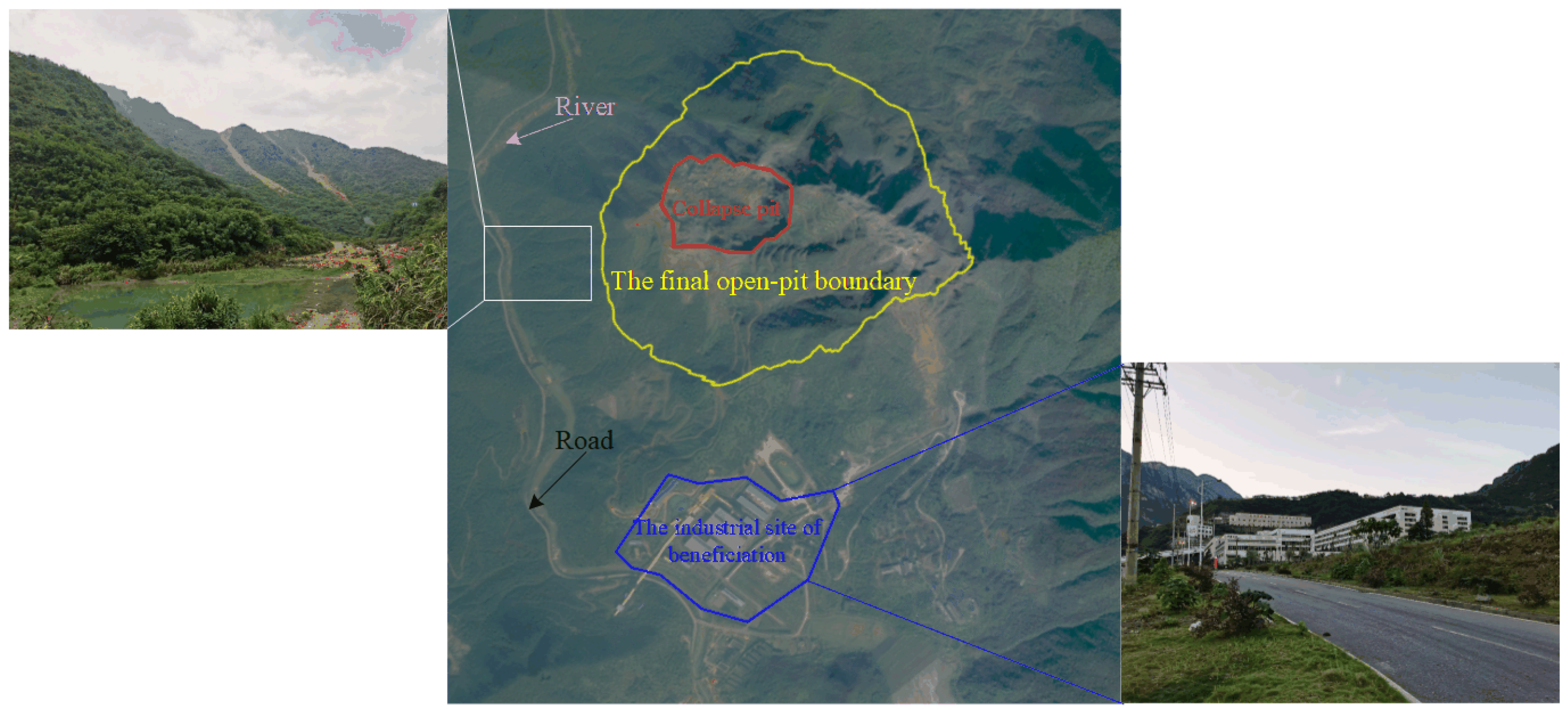
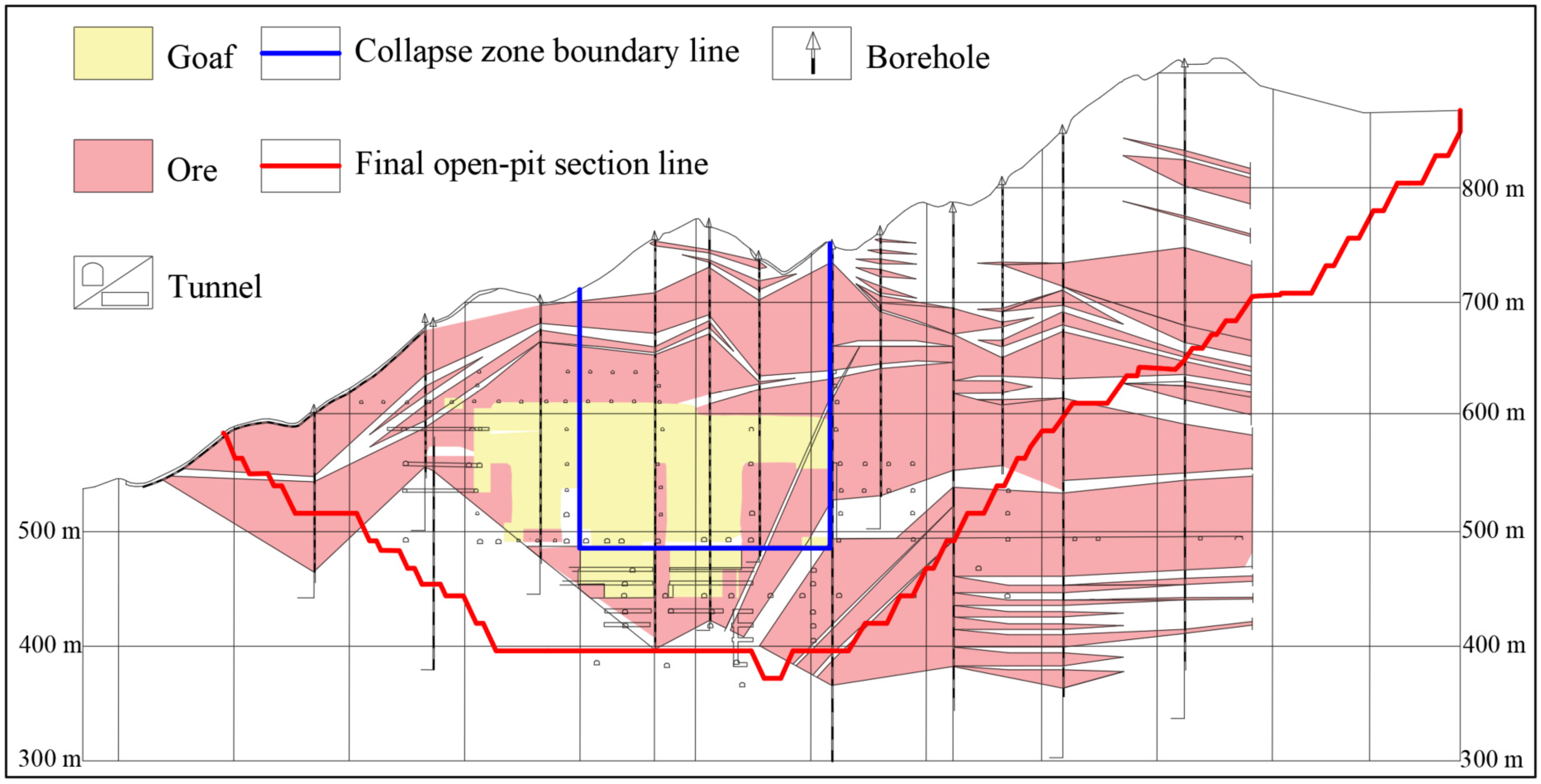
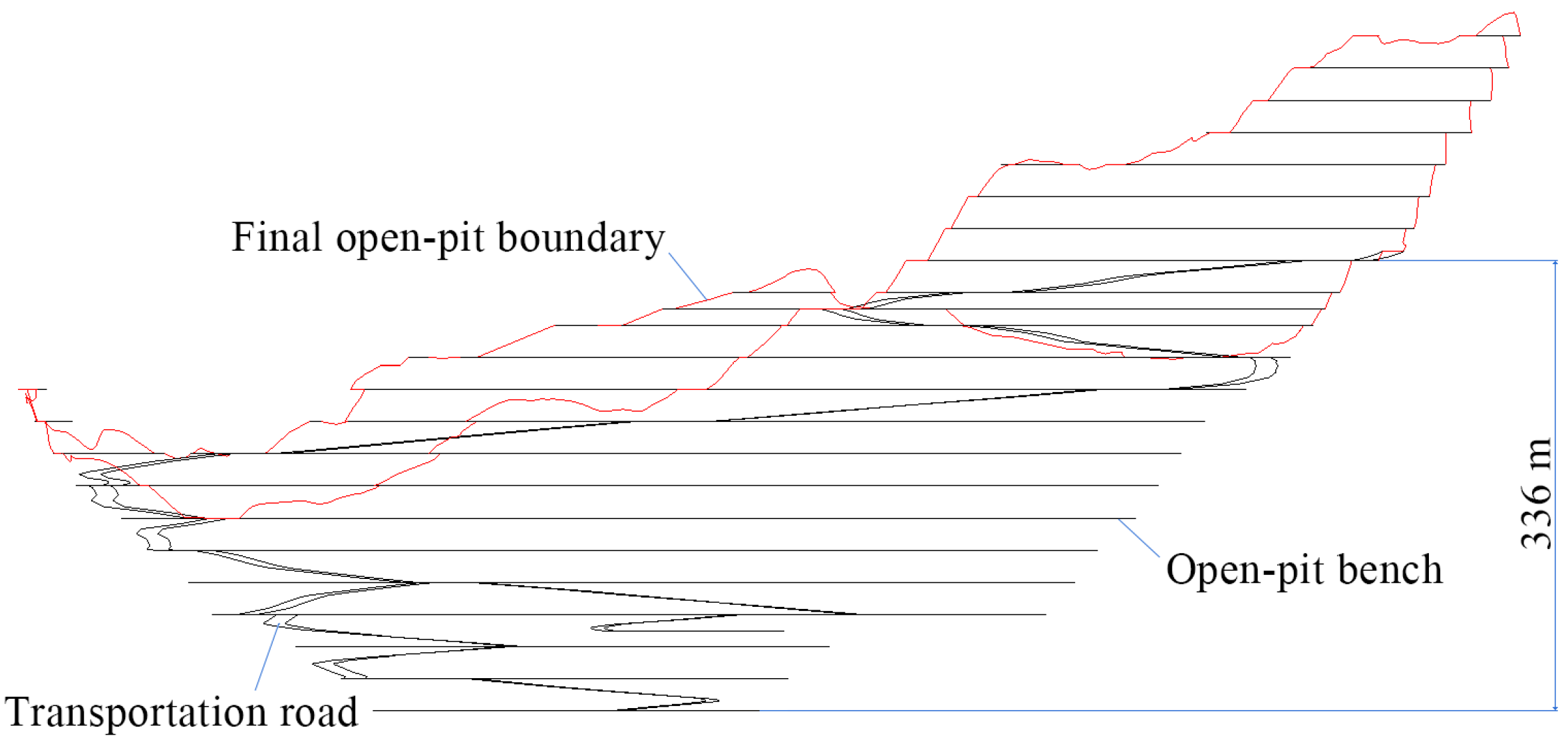
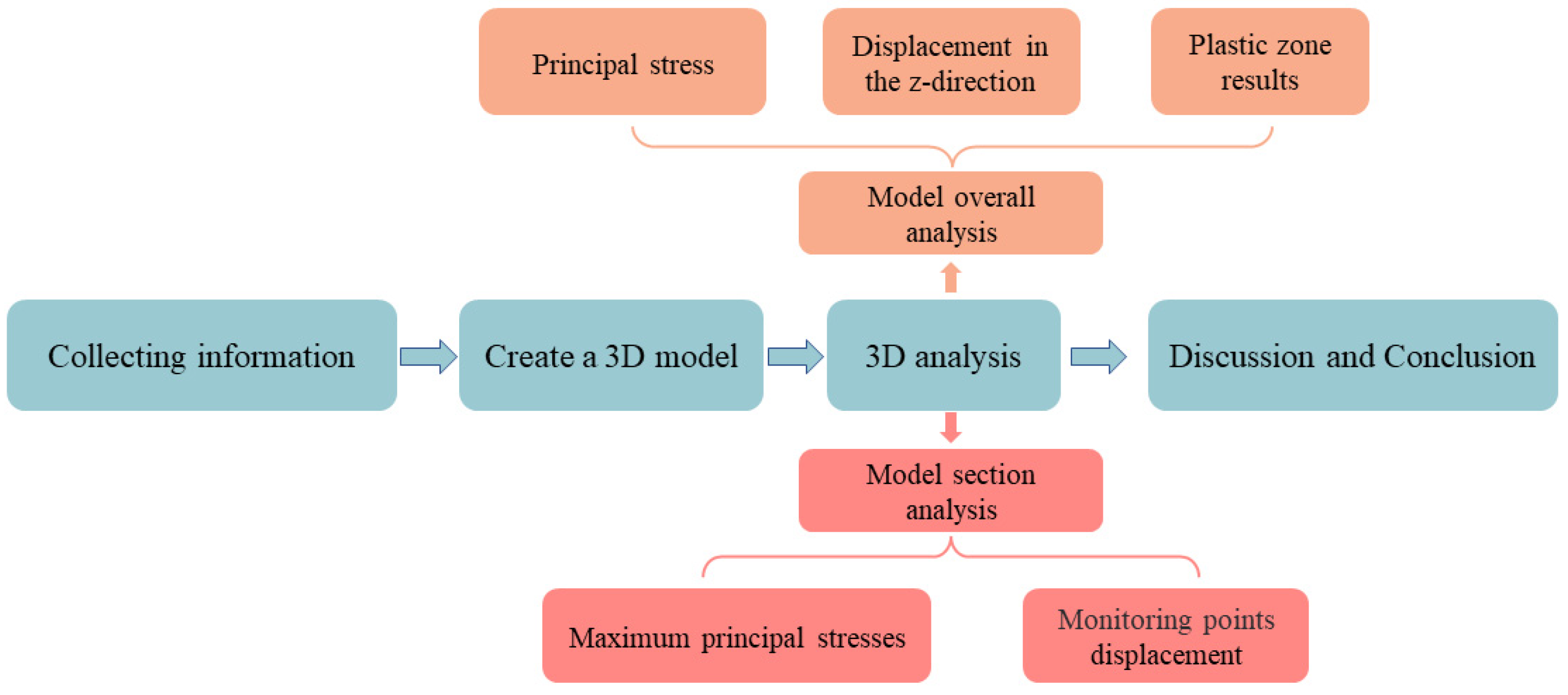
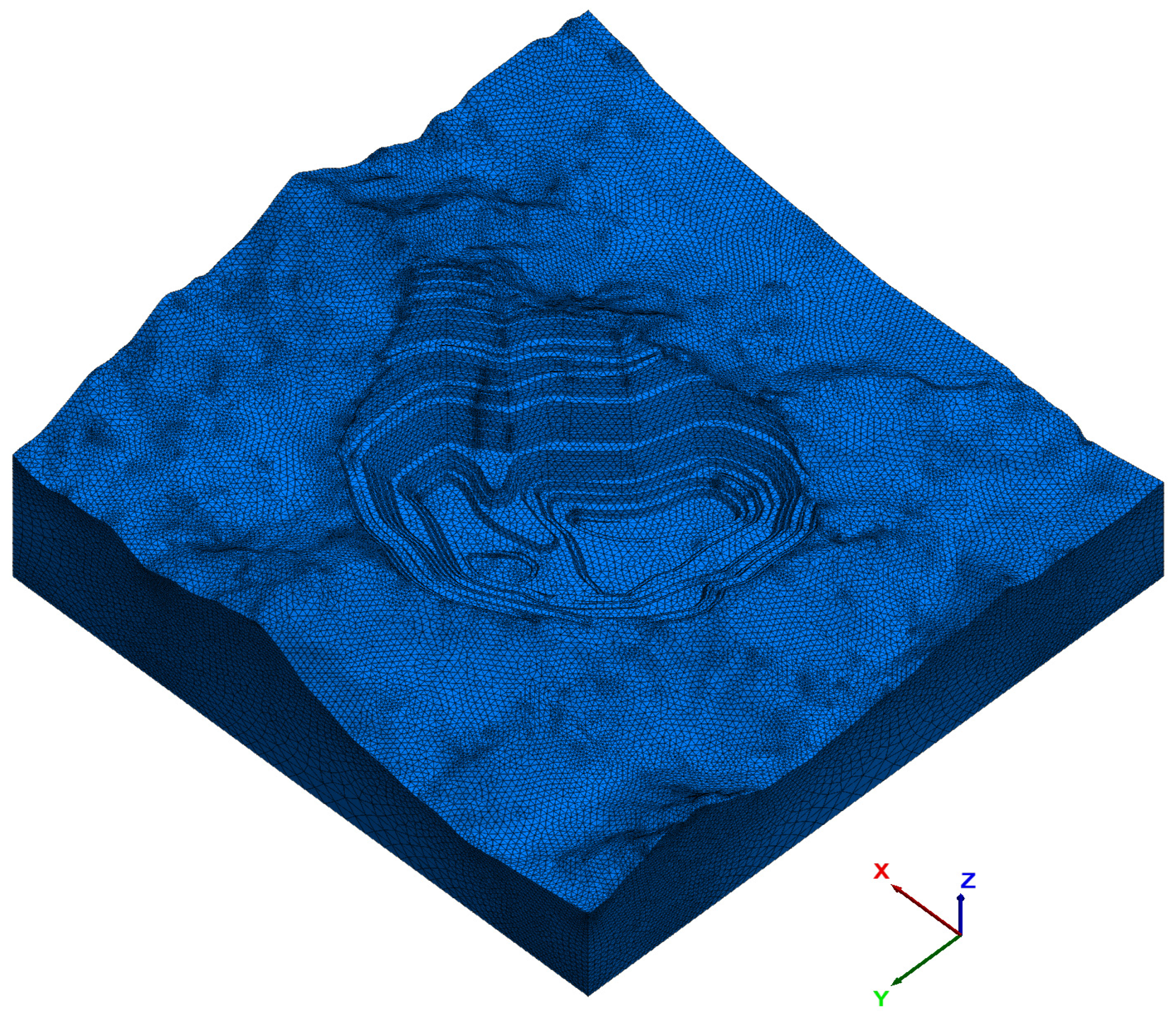
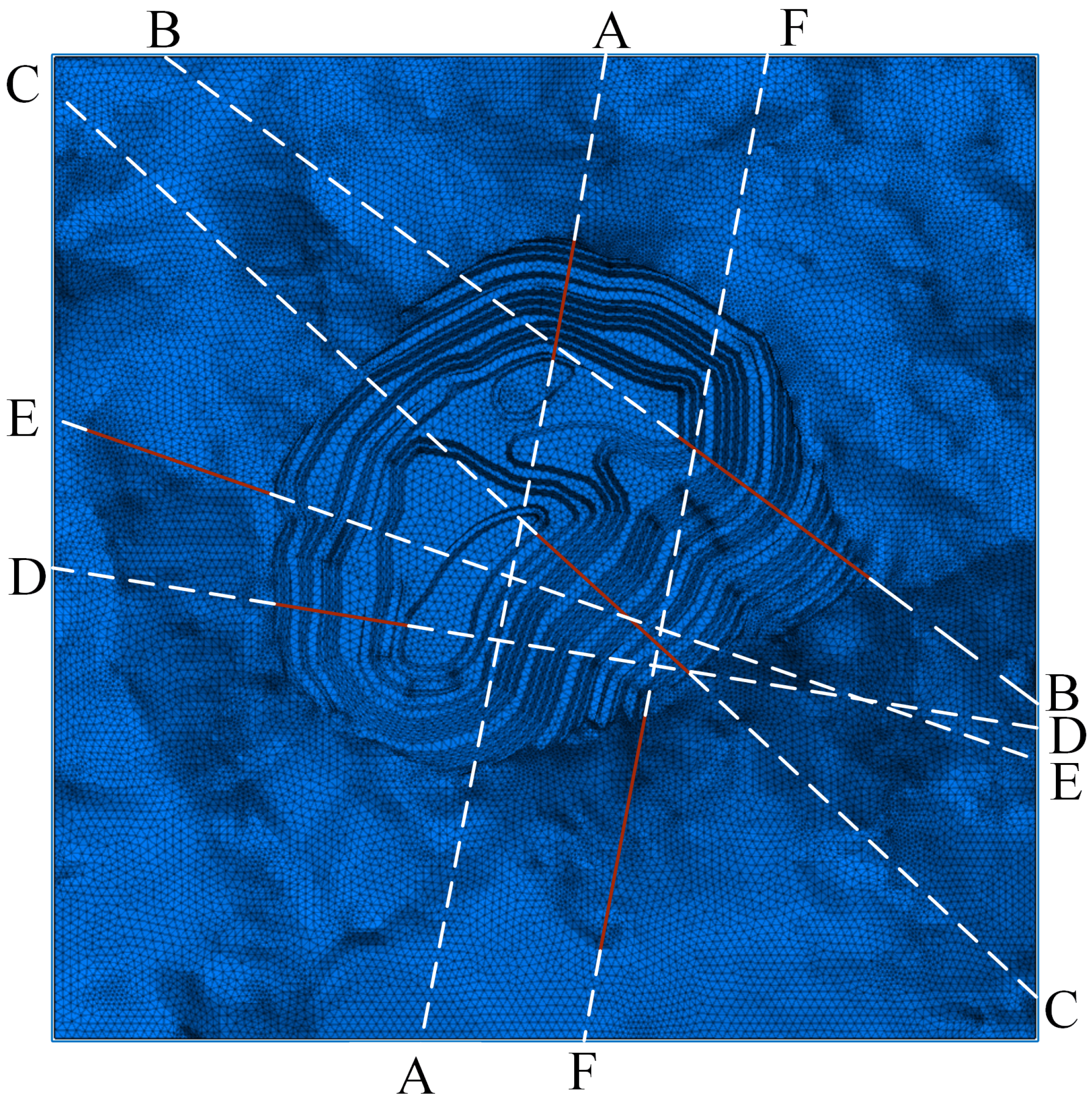
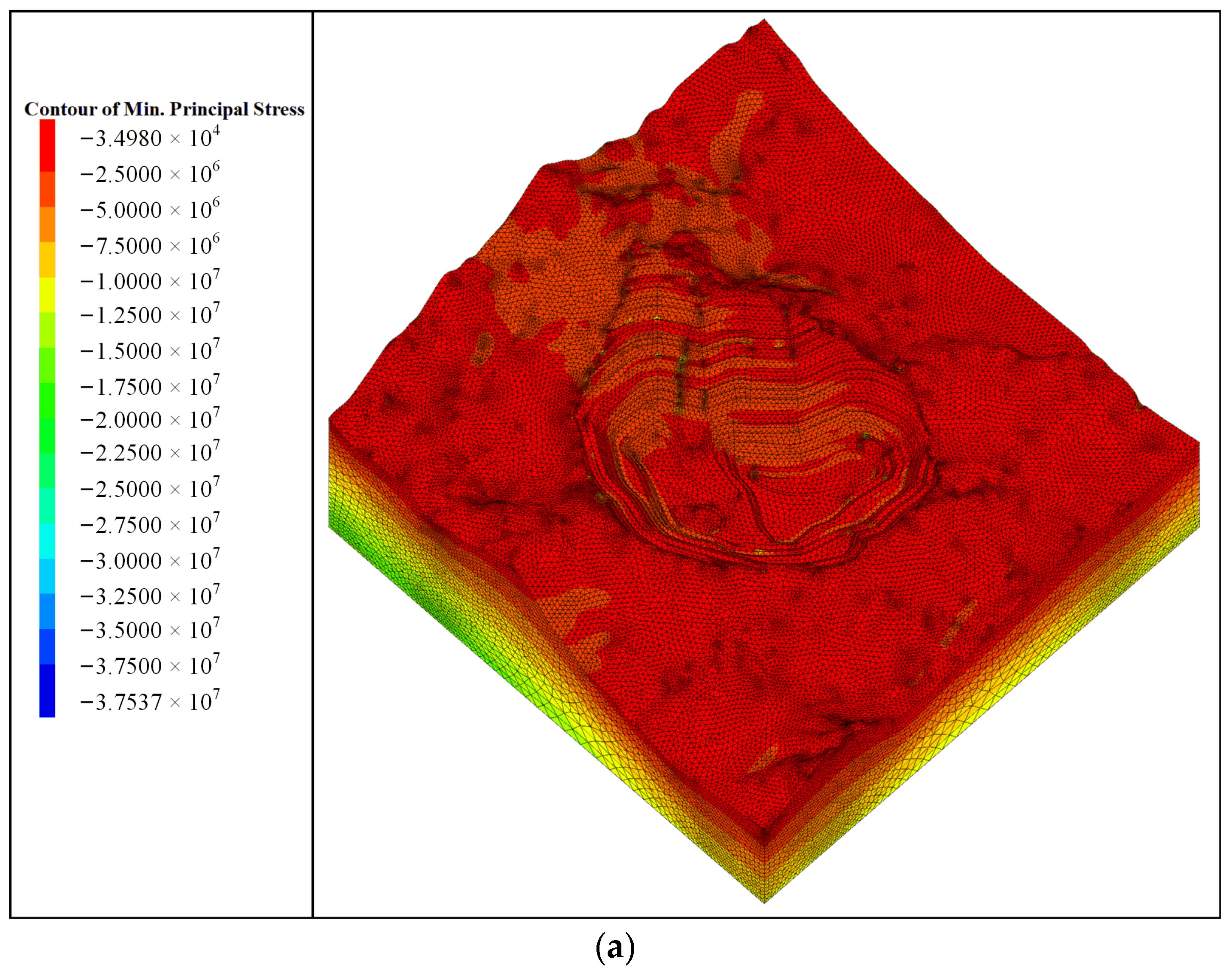
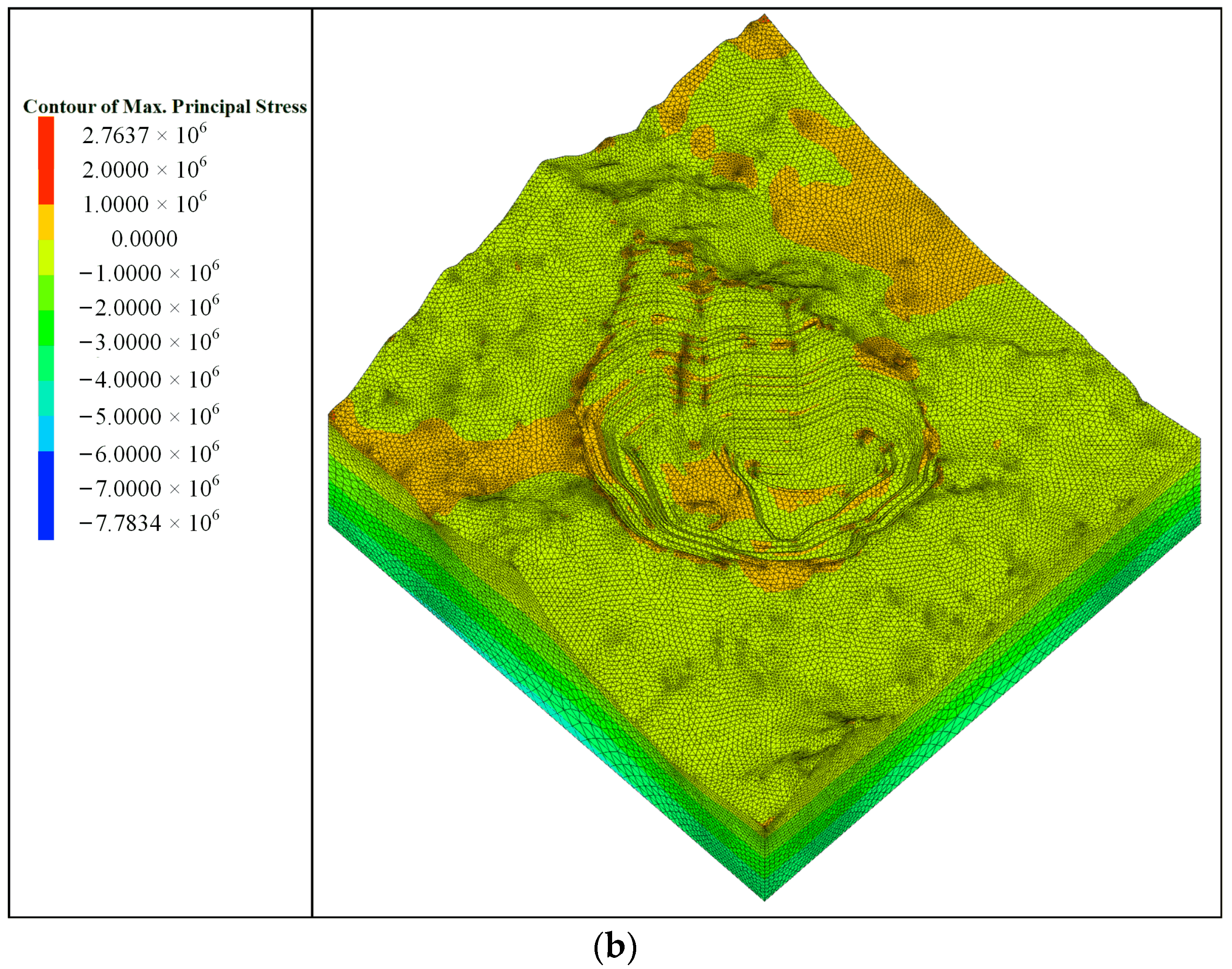
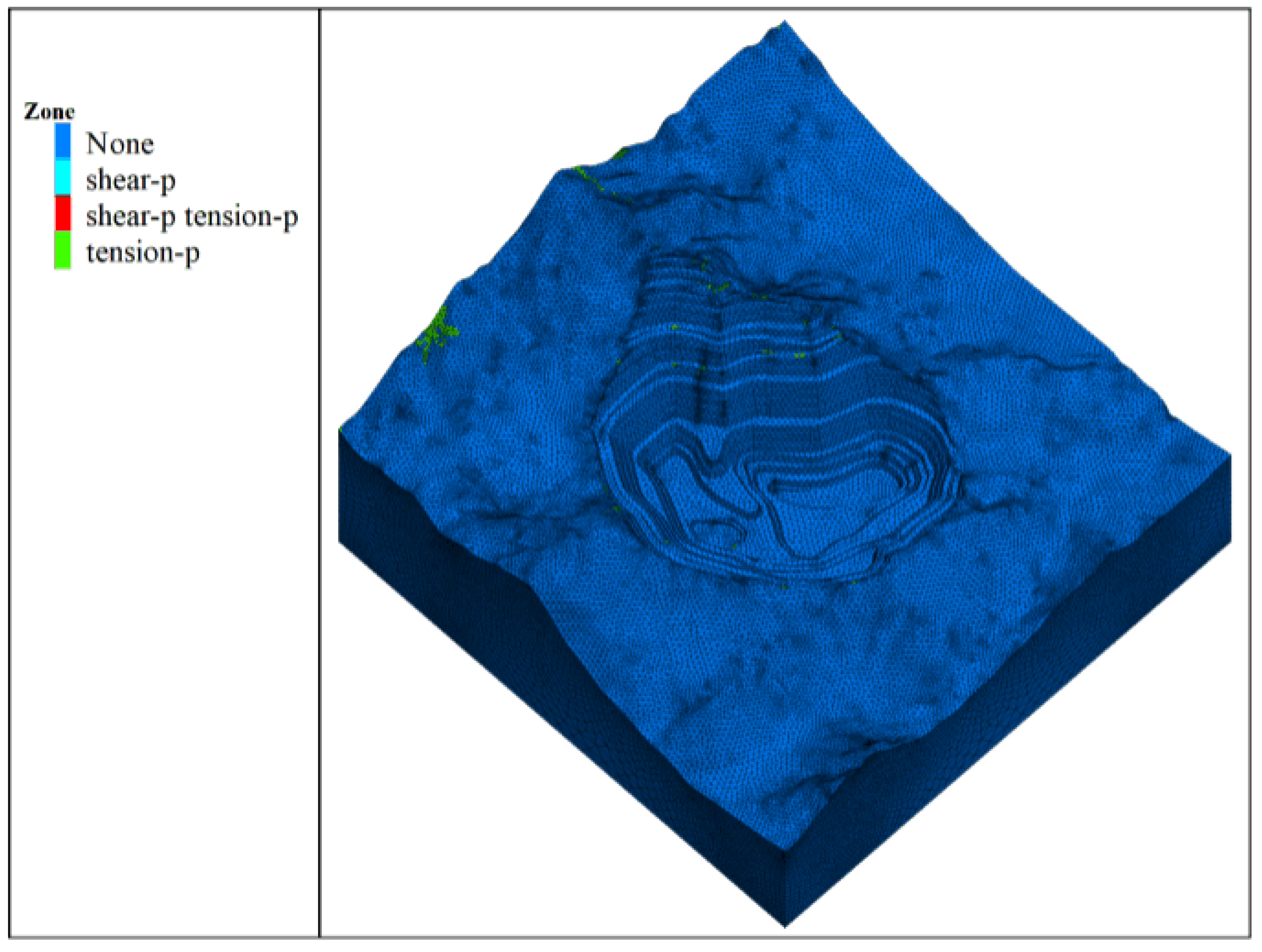
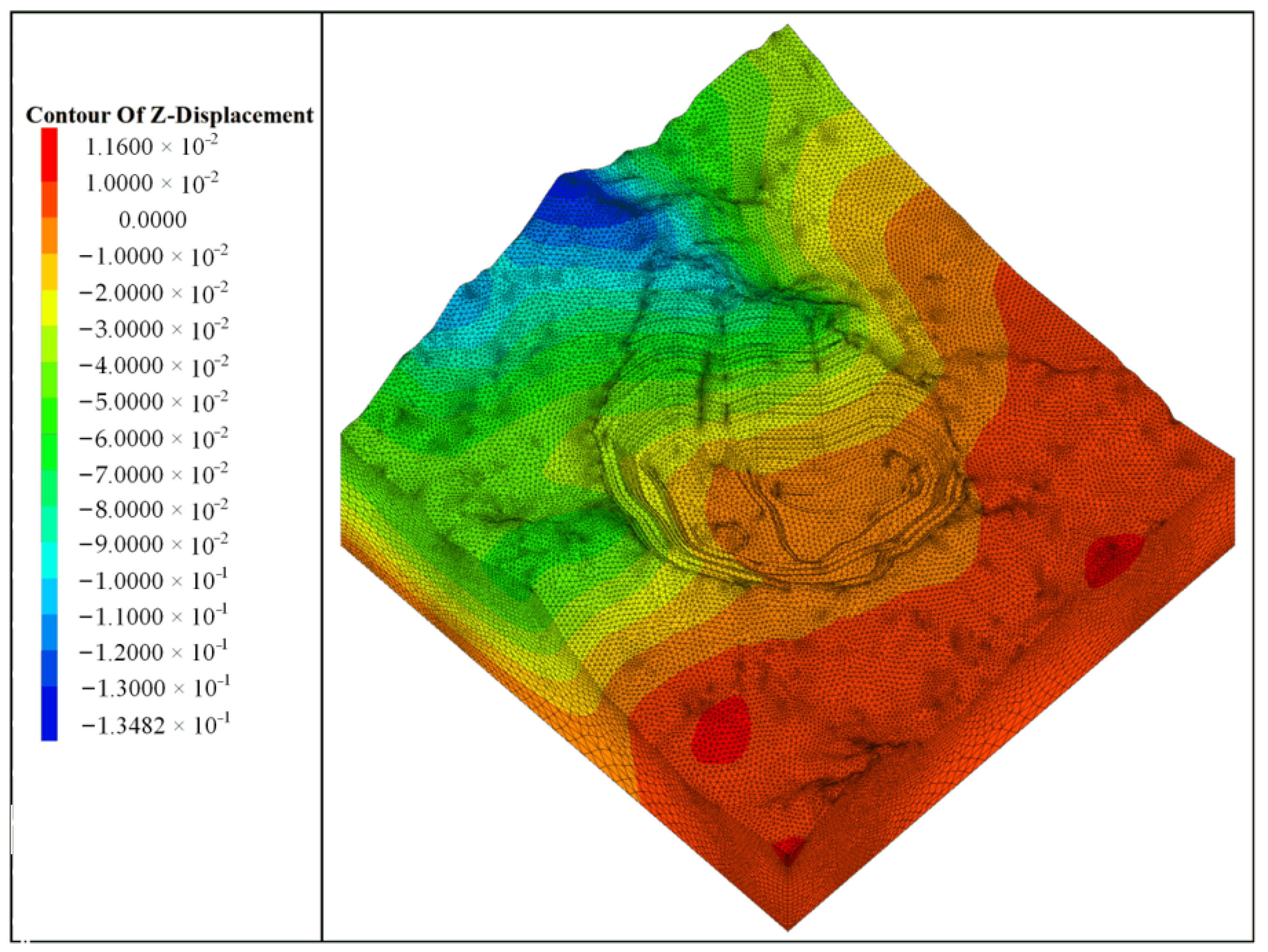
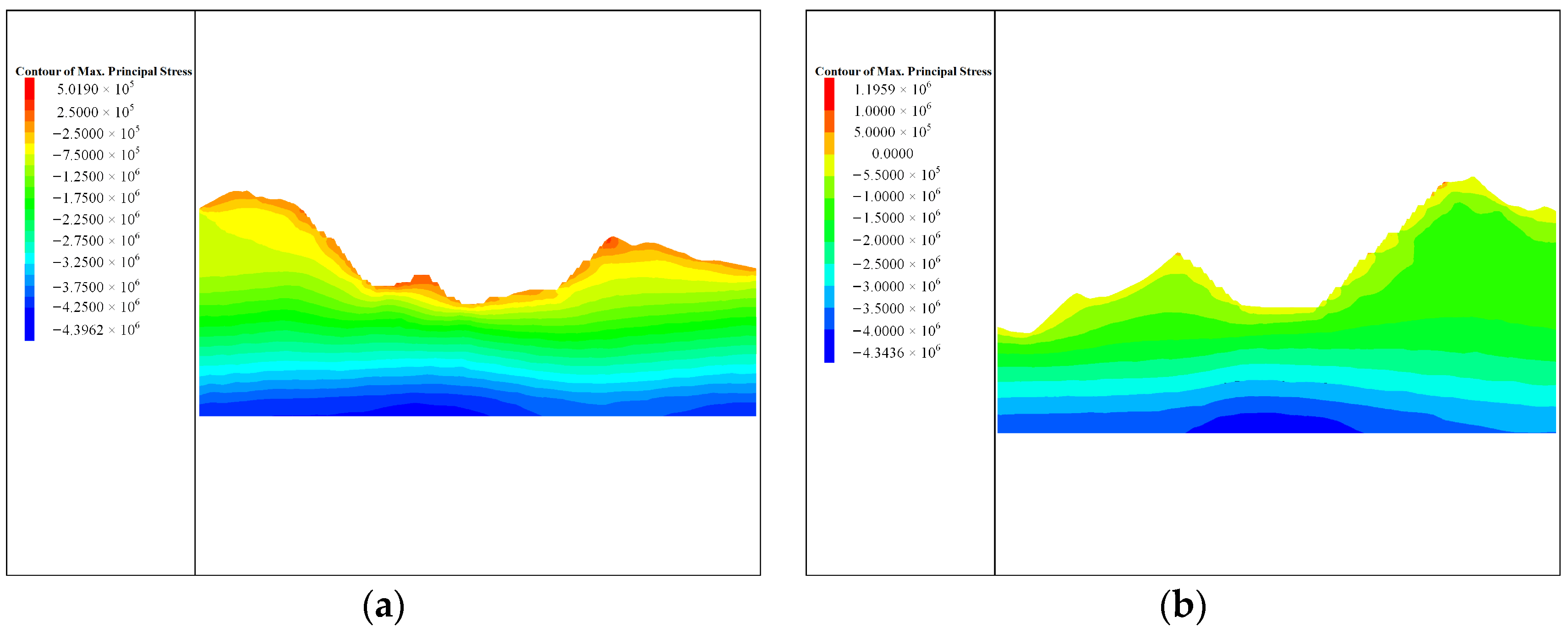
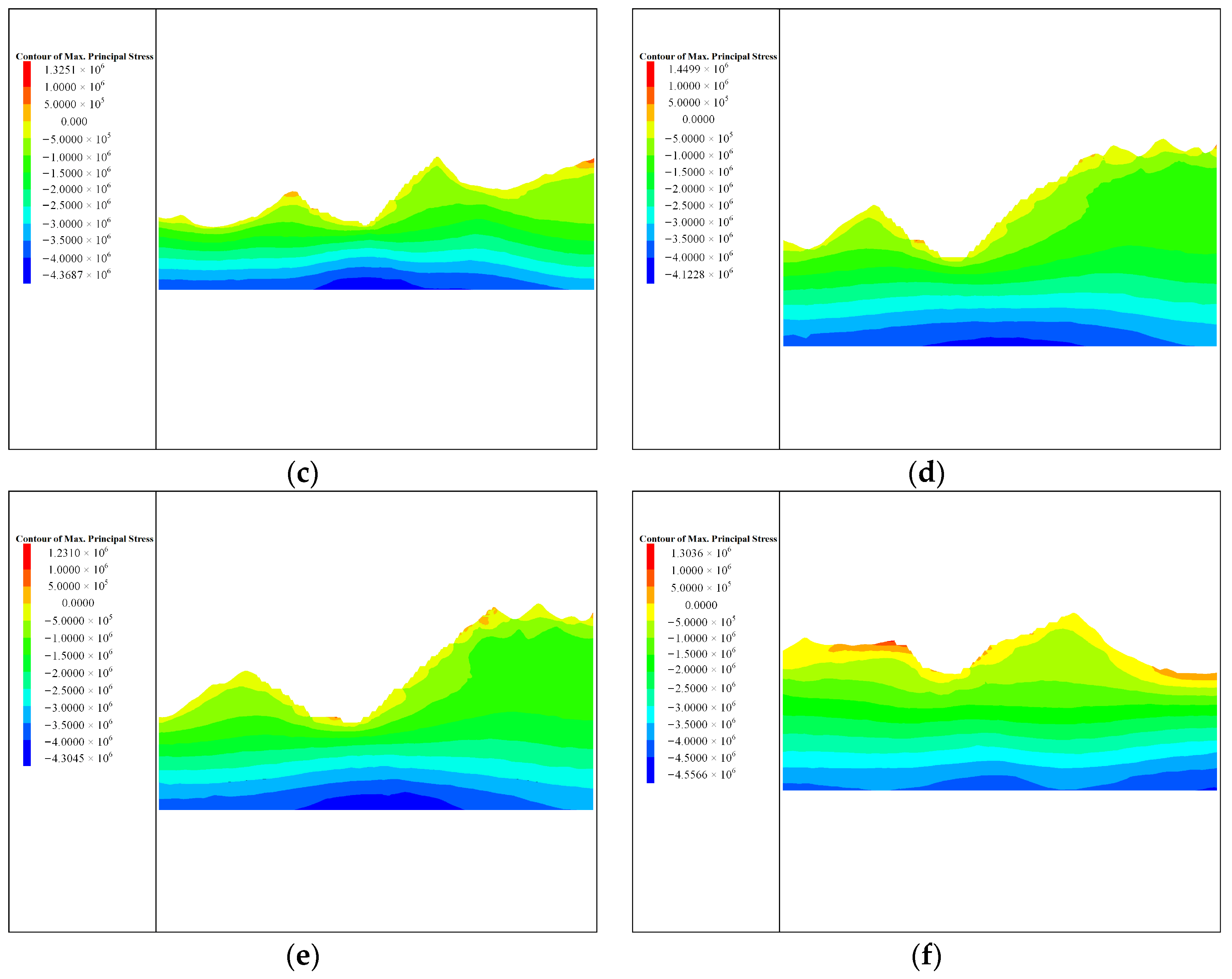
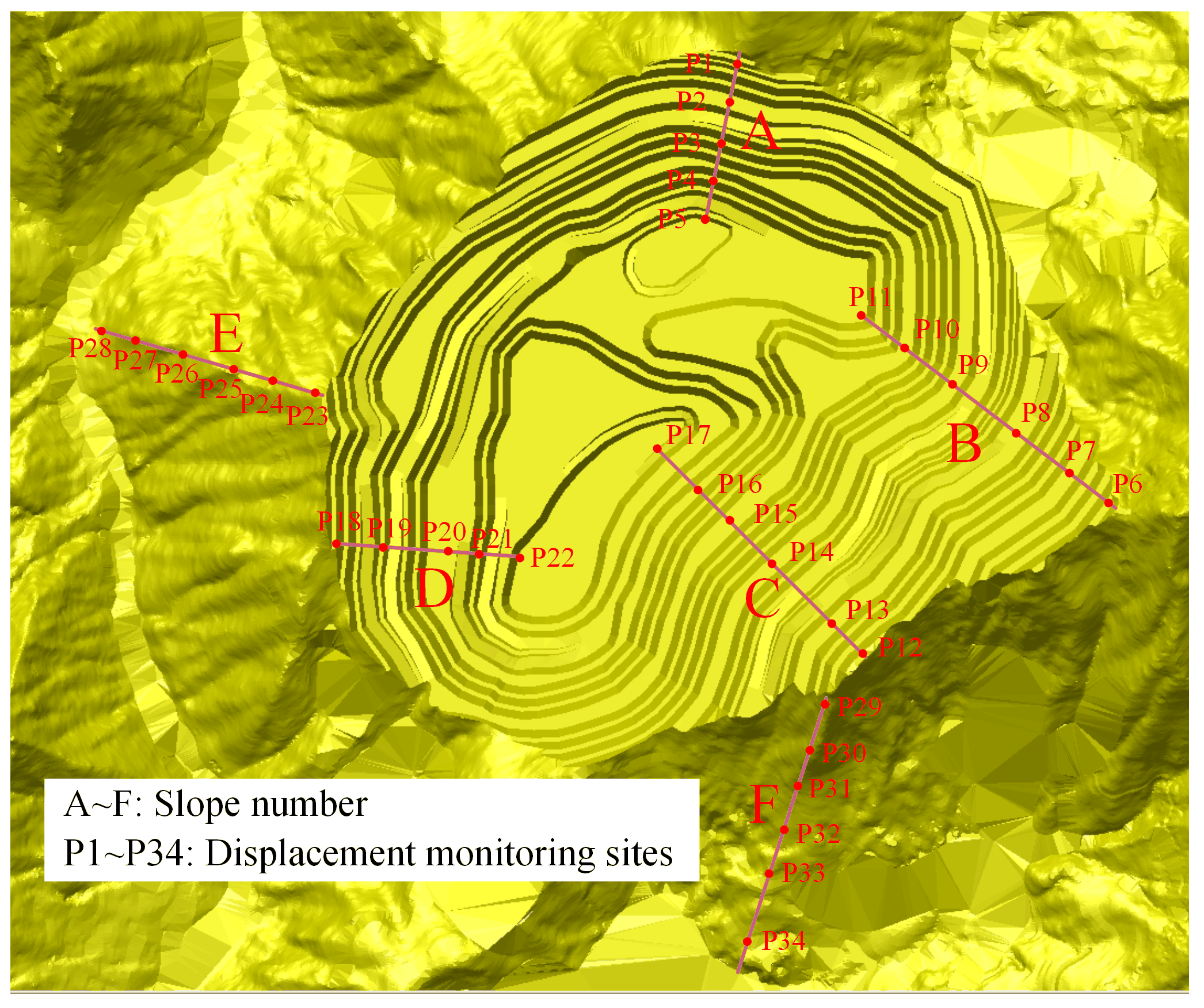

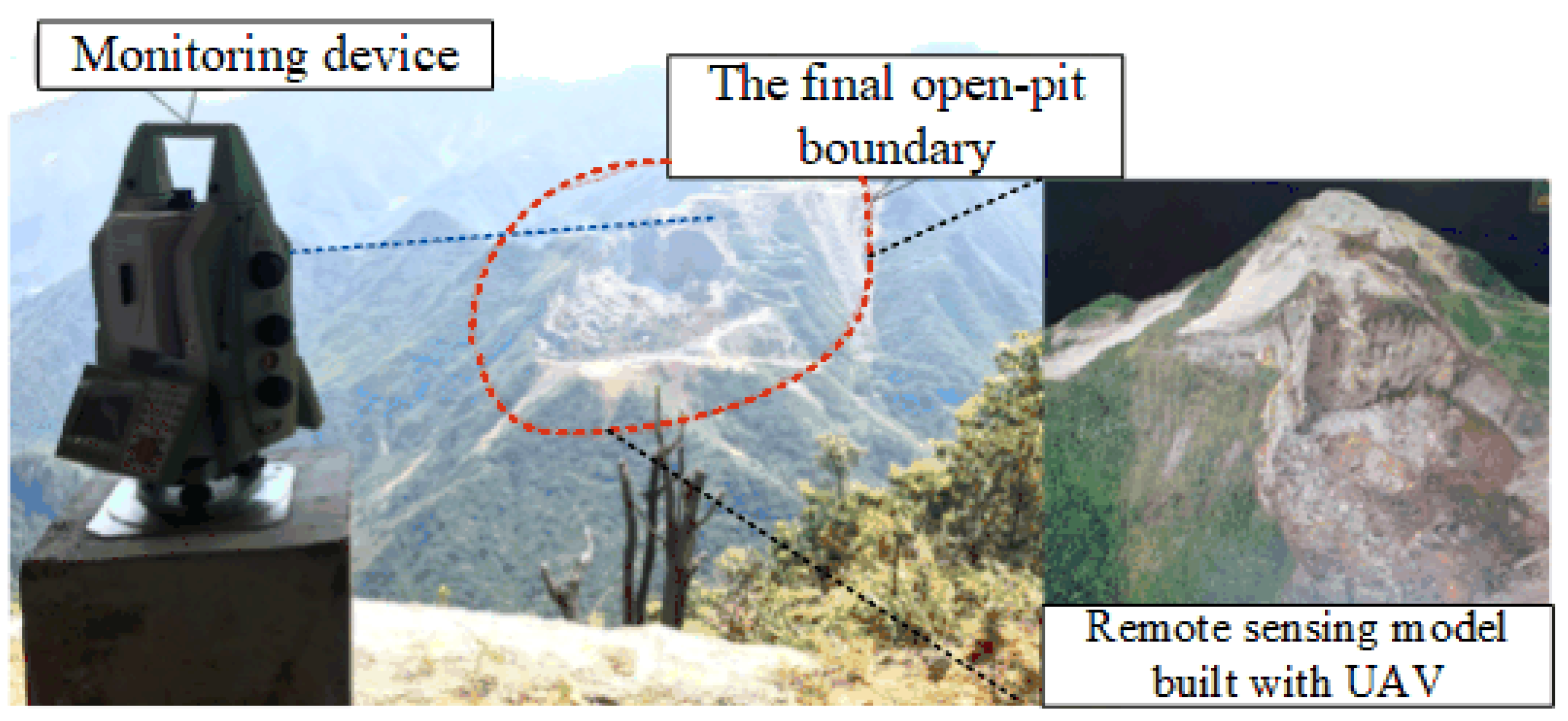
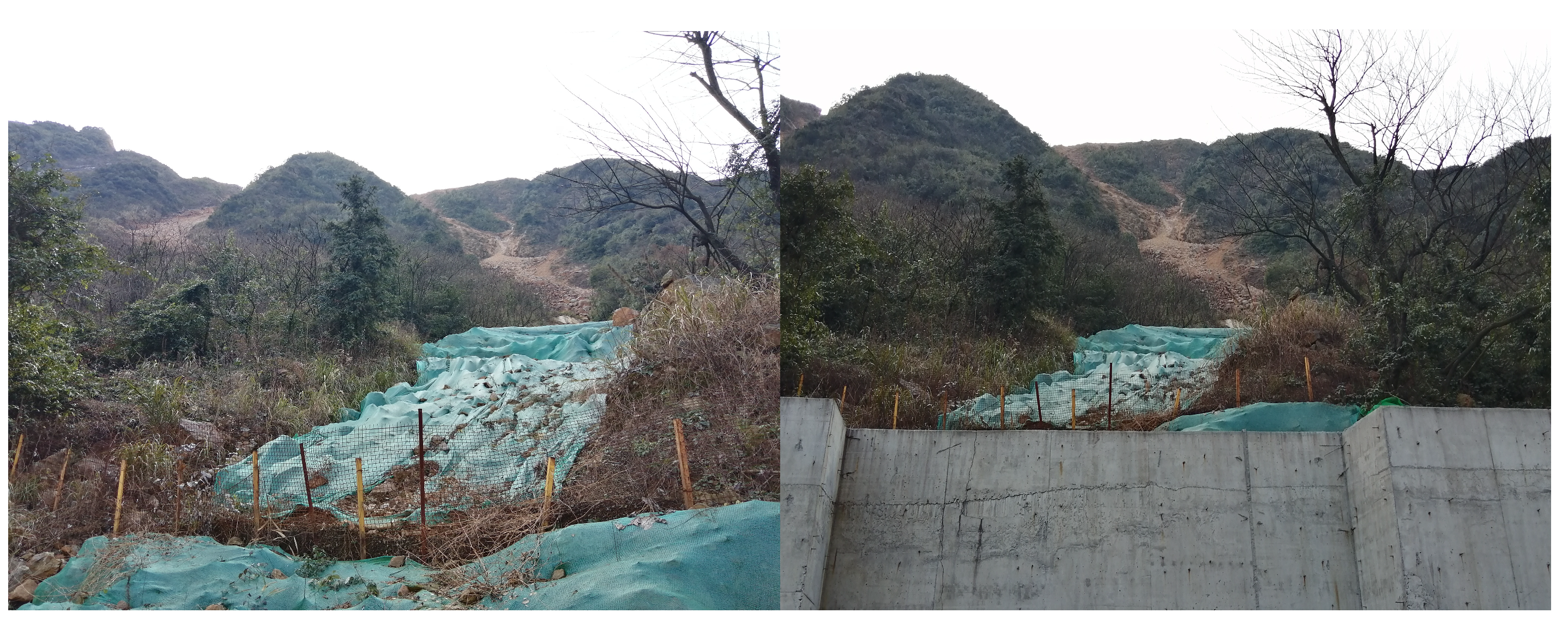
| Lithology | Elasticity Modulus (GPa) | Compressive Strength (MPa) | Tensile Strength (MPa) | Poisson’s Ratio | Unit Weight (kN·m−3) | Cohesive Force (MPa) | Internal Friction Angle (°) |
|---|---|---|---|---|---|---|---|
| Granite | 37.670 | 102.590 | 7.04 | 0.2381 | 25.810 | 6.73 | 43.630 |
Disclaimer/Publisher’s Note: The statements, opinions and data contained in all publications are solely those of the individual author(s) and contributor(s) and not of MDPI and/or the editor(s). MDPI and/or the editor(s) disclaim responsibility for any injury to people or property resulting from any ideas, methods, instructions or products referred to in the content. |
© 2023 by the authors. Licensee MDPI, Basel, Switzerland. This article is an open access article distributed under the terms and conditions of the Creative Commons Attribution (CC BY) license (https://creativecommons.org/licenses/by/4.0/).
Share and Cite
Li, S.; Zhao, Z.; Hu, B.; Yin, T.; Chen, G.; Chen, G. Three-Dimensional Simulation Stability Analysis of Slopes from Underground to Open-Pit Mining. Minerals 2023, 13, 402. https://doi.org/10.3390/min13030402
Li S, Zhao Z, Hu B, Yin T, Chen G, Chen G. Three-Dimensional Simulation Stability Analysis of Slopes from Underground to Open-Pit Mining. Minerals. 2023; 13(3):402. https://doi.org/10.3390/min13030402
Chicago/Turabian StyleLi, Shuai, Zeming Zhao, Boyi Hu, Tubing Yin, Gong Chen, and Guohui Chen. 2023. "Three-Dimensional Simulation Stability Analysis of Slopes from Underground to Open-Pit Mining" Minerals 13, no. 3: 402. https://doi.org/10.3390/min13030402
APA StyleLi, S., Zhao, Z., Hu, B., Yin, T., Chen, G., & Chen, G. (2023). Three-Dimensional Simulation Stability Analysis of Slopes from Underground to Open-Pit Mining. Minerals, 13(3), 402. https://doi.org/10.3390/min13030402







